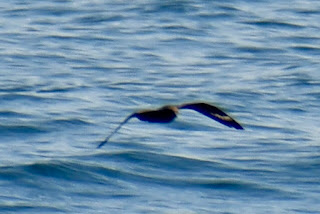7/14/24 - South Polar Skua
This past Sunday I joined my friend Captain John on another tuna fishing adventure. We did slightly better this time than our previous trip. We boated one yellowfin tuna on Sunday whereas we were skunked the previous Monday. There were plenty of Wilson’s storm-petrels around, but no tuna. What we needed to find out on the water was a more communal feeding event, such as one that also includes shearwaters, whales and dolphins. Tuna would certainly be in the area. There were no such feeding frenzies in the areas that we covered. The marine life in general on Sunday was slower than the past few trips. We saw only one distant whale and just a few dolphins. Other than plenty of storm-petrels, I was able to pick up just a couple great shearwaters and several Cory’s shearwaters.
Left, great shearwater. Right, Cory’s shearwater. © S. Weiss
Five Cory’s shearwaters sitting on water. © S. Weiss
In mid-morning we came upon two commercial fishing boats. They were netters. What they were netting I am not really sure, maybe shrimp or squid? Either way, following commercial boats can be productive for sea birding since they churn up the bottom and drop scrap food in their wakes. Last August, on a Cape May pelagic, we spotted a white-faced storm-petrel following a commercial boat. Last September when I was out in Westport, WA we followed a few commercial boats that had attracted black-footed albatrosses, fulmars and plenty of shearwaters. The only tuna of our day was caught when we first neared the netters.
For the day, bird life was best around the commercial boats. I had as many as four Cory’s shearwaters and one great shearwater. Shortly after 10 a.m. I spotted probably my best bird of the year so far. I saw a large brown bird sitting out on the water. I first thought it to be a shearwater. I looked at a couple of quick photos I took of the bird and realized it was not a shearwater. It was rather bulky with no black cap, so it wasn’t a great shearwater. Its bill was a little short and stout, and all dark, so it was not a Cory’s shearwater. I began to suspect a south polar skua and needed better photos to confirm or debunk my hunch. The bird lifted off and flew opposite the direction that we were trolling. In flight it showed bold white flashes at the base of its primary feathers. Now I had to rule out a jaeger species.
Left, south polar skua sitting on water. © S. Weiss
Notice bulky size and short, all dark bill. Right, south polar skua (upper right) approaching Cory’s shearwater (lower left). Notice wing flashes, short tail and overall size compared to the shearwater.
South polar skua. © S. Weiss
Notice broad wings and white flashes at base of primaries on top and underside of wings.
Since I was the only birder on the boat, I was not going to ask the captain to turn around and follow the bird. He and the others aboard were looking for tuna. I kept eyes on the bird as it settled back on the water several hundred yards behind the boat. I took as many photos of the bird as I could until we were too far away to make it out any longer. It settled back down near a Cory’s shearwater that was trying to eat a piece of scrap from the netting boat. I could see its large size in comparison next to the shearwater. The flight photos showed bold white flashes on both the upper and under wings. Its bill was not bicolored and there was no barring on its chest or belly that might suggest a subadult jaeger. I was pretty sure I had my second south polar skua for New Jersey. I had seen one last June off of Cape May, and several during pelagics in North Carolina and Washington.
Back at home, photo reviews helped me eliminate probably the next likely species, a pomarine jaeger. The skua had broad wings and a short tail, unlike a pomarine jaeger. Also, all the jaeger species are smaller than a Cory’s shearwater, unlike the bird in my photos. South polar skuas are rare, but not unexpected off of New Jersey. Since 1976, there have been only 25 accepted records of south polar skuas off of New Jersey (https://njbrc.com/documents/ARL.pdf). They are open sea bullies that habitually chase and harass other sea birds for their food. They breed in Antarctica and some roam to the North Atlantic Ocean in the summer months. Like their winter counterpart, the great skua which breeds in the north, they are prized finds for pelagic birders.
South polar skuas. Left, Westport, WA. Right, Hatteras, NC. © S. Weiss
South polar skuas are usually spotted singly. Occasionally, viewers are treated to a pair of birds.
I can’t speak for my fishing colleagues, but a successful day out on these fishing trips is catching at least one nice fish and spotting at least one nice bird. The skua made my day.












Comments
Post a Comment